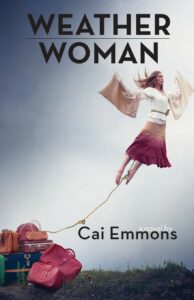
Traitor or Heroine? Deciphering an 80-year-old British WWII secret (Boston, London, Paris; 1928-1941 and present-day): Put on your thinking caps! Play detective and investigative reporter in this twists and turns WWII mystery uncovered by a fictional journalist, who makes the case for why we can’t get enough of well-researched WWII fiction with terrific prose.
Katherine Reay, who’s written seven other novels, isn’t new at this, but her new did-she-do-it WWII story offers new historical information apparently released in 1998. Still, we don’t know what was left out, and/or what might have been covered up, either cryptically, codified, or altered in some other way. This, then, is a complex novel for figuring out whether history was right or wrong when two intrepid, personally invested characters are determined to find out the truth. With names sometimes kept the same through three generations, codes used, genealogy to keep straight, and a lot of history tracked, The London House engages mystery lovers, historical or otherwise.
Pay attention to clues found in the novel’s significant epistolary format woven throughout: letters, diaries, archival notes, and war telegrams that feel voyeuristic and authentic. The narrative parts between the two main characters from Boston – Caroline Waite Payne and Mat Hammond – help to guide us.
A fictional article Mat has written for The Atlantic magazine drives the plot. He’s ready to hit the button to send it to his editor. He still has some time before his deadline although limited, so you’ll feel the pressure as the hunt gets closer to it. A fine, ethical journalist, he knows his article would be even better if an ancestor would preview it, provide comments, and sign off on it. The obstacle is the Waite and Payne families avoided digging into the story believing the truth was too painful, so they dwelled on the shame of it: that one of the daughters, a twin, of the original descendants of nobility was a traitor, so her death delivered justice.
Mat believes there’s more to the story, that his article may not have all of it. We see how that plays out. The family member he reaches out to he had a close relationship with six years ago in college. Her grandmother Margaret was the twin sister of the woman at the center of the mystery – Caroline Amelia Waite born in 1918. Fast forward to the present-day, to third generation, twenty-eight-year-old ex-friend also named Caroline – Payne. She sensed her grandmother’s sadness but never knew why. She’ll find that out after Mat convinces her to get involved, but not until nearly the end.
His Atlantic piece proposes history can be wrong. That’s the intellectual part. The emotional part is found in the affecting prose, in complicated relationships. Past ones include the changing relationship between the twin sisters and an entangled love story. Present ones are between 1) Caroline and Mat, seen in romantic tension, 2) Caroline and her British father, adamantly against anyone unearthing this story after all these years, 3) Caroline and her older brother (married with a child also named Caroline), who doesn’t want her to do anything to upset their father surviving cancer, and 4) her divorced mother living in The London House. All these relationships are put to the test, all fraught when the story begins.
At sixteen, Caroline Waite left America for London. She lived at the family’s countryside mansion in Derbyshire named Parkley, then moved into the London House, which holds memories of fear and betrayal – “the hollowness of utter defeat.” Present-day Caroline was told her great-aunt was a victim of polio, which wasn’t true. On page 10 of this 350-page book (so not much of a spoiler), Mat tells Caroline the great-aunt she didn’t know was a secretary in Winston Churchill’s WWII secret intelligence operations SOE (Special Operations Executive), then supposedly fled with her “Nazi lover.” The other side of the story is what-if she was a British spy and something went wrong?
The female spy network has been the subject of other historical novels (see https://enchantedprose.com/code-name-helene/) and nonfiction books, but they were about known spies. Reay keeps us guessing whether Caroline Waite was or wasn’t. Listen to a real Churchill SOE agent who could be speaking for Caroline Waite – or not.
A great opening quote by Alan Turing, the genius British mathematician who broke the German Enigma code that ended WWII, is the first hint that “sometimes it is the people no one imagines anything of who do the things that no one can imagine.”
One of my favorite parts is what Mat’s written. Aimed at confirming or correcting the past, it feels, pointedly, for us, for today and our future. Here’s an excerpt:
“In a time that necessitates reaching for the past to understand our present and navigate our futures with greater intention, there is a call to memorialize our shining moments, our sacrifices, our heroes. As we grapple with the aftermath of a world pandemic, tumultuous elections, social upheaval, the rise of sectarian interests, intolerance, and financial insecurity across the globe, we find ourselves examining the past to find the firm footing our present fails to provide . . . Contrary to popular ethos, I have found greater growth and understanding come from our failures. It is the fallen who reveal to us our humanity, our perseverance, our yearning for right, our resilience, and our determination to stand after stumbling . . .”
Around 100 pages in, you’ll realize Mat is right: he does not have the whole story. The Waite family accepted their daughter’s death but her body was never found.
A different type of tragedy befell Caroline Payne’s family when her younger sister, interestingly named Amelia, died two years ago. She grew up feeling she deserved her parents’ emotional abandonment, blaming herself for her sister’s death. Her self-perception that she can never be good enough may be flawed but it’s believable.
Caro’s (nickname) story begins in a 1941 Prologue in Paris when she’s working at the “ninety-eight-room mansion” of the House of Schiaparelli – the legendary, flamboyant fashion designer inspired by Surrealism – fitting her bold, daring personality.
Caro’s close friend and colleague, Martine, is fleeing the “too dangerous” 1941 city but she believes “Schiap keeps me safe.” Bringing Paris’ haute culture into the story adds charm and heady times before Germany invaded France. Focusing on the designer outspoken about Germany’s fascism and yet the only reason her showroom wasn’t shut down was she catered to wealthy Germans – versus her rival Coco Chanel believed to be a Nazi spy – exposes conflicting wartime ideologies, attitudes, and hypocrisy, real and necessary to stay alive.
Caro’s precarious situation quickly switches to the now, when Caroline receives a call from Mat. Immediately, she recalls his “electric smile” and his determination and brilliance that were “challenging,” accompanied by a vague feeling of “longing.” His persistence and energy challenges her once again, and us, when he tells her that his story, “your story,” can “provide a sense of hope.” He goes on to say that history can “assure us that when bad things happen, life continues, and that we humans are resilient and endure. Hope emerges from tragedy.” That “how we deal with pain and adversity remains relevant no matter how long ago it happened.”
Is this why we can’t get enough of WWII fiction? Arriving before the holidays after nearly two years of hopelessness, history is a gift.
Lorraine





